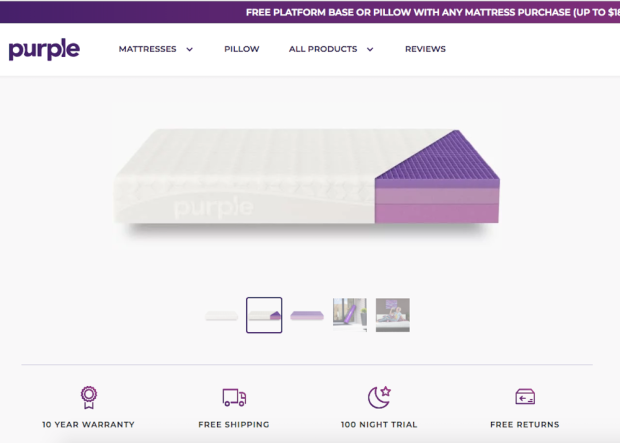Purple And Why Retail Is Going To The Mattresses

Mattress shopping has undergone a seismic shift in the last five years that likely would have been hard to predict from the outside. Since Casper introduced the world to the concept of a mattress in a box in 2014, the competition has become multi-faceted and fierce, and startup players like Tuft & Needle and Purple have popped up in the marketplace, hoping to the be the box (or hexagonal cardboard tube, in some cases) that arrives at a customers’ door.
The market, as of this week, has gotten quite a bit more competitive. Amazon has officially thrown its hat into the ring, offering a line of 12-, 10- or 8-inch memory foam mattress through its AmazonBasics brand. The mattress is a first of its kind offering for Amazon — though it does sell other memory foam mattresses on its marketplace — but it fits in nicely with a range of other bedroom-focused goods, including bed frames, bedding, sheets and pillows. The mattress offering completes the set, so to speak.
It is Amazon’s latest private label offering, noted SunTrust analyst Youssef Squali, and the latest weapon in an arsenal of offerings that is becoming particularly potent, especially in combination with each other.
“As strong an eCommerce platform as Amazon has become over the last 20 years, we believe that the best has yet to come,” Squali wrote. “Private label is one of the highly under-appreciated trends within Amazon, in our view, which over time should give the company a strong … competitive advantage.” Squali also forecast that Amazon could see as much as $25 billion in revenue via those offerings as of 2022.
That may be good news for Amazon — and perhaps customers in the market for a new mattress — but it is also a fairly loud shot over the bows of its competitors. Amazon’s mattress comes in at a much lower price than its competitors’ mattresses. A queen-sized mattress will cost Amazon customers around $260 — a comparable mattress on Casper, Tuft & Needle or Purple will run between $600-$1,000.
In all markets, there are many options and various types of consumer values. Consumers in all areas of their lives make decisions about the quality levels they need, from cars to clothes to food. A mattress is a consumer good like all others — some customers will be motivated by price, some will be motivated by convenience and some will want comfort.
So far, Purple has found plenty of consumers willing to pay a bit extra for that experience. The firm reported being profitable two years after its initial mattress launch, with around $190 million in net revenue last year.
But the pressure is on, particularly in a crowded field, to continually recruit new customers and bring them into the Purple experience. The retailer has made a continued effort to expand and aggressively pursue several sales channels as it scrambles to rise above the crowd.
In June, Purple expanded its partnership with Mattress Firm to 16 stores in San Francisco, following an announced move into the retailer’s Chicago stores. Mattress Firm has been selling Purple mattresses in Sacramento, Austin and Washington, D.C. since 2017.
Purple also has a very notable presence on the Amazon Marketplace, though, with Amazon now offering a mattress of its own, the fate of that remains to be seen.
Purple is not the only player pushing a multi-channel effort. Casper has been highly involved in building it its own stores, testing pop-up shops and partnering with Target for additional distribution.
The race, which was already tight, has now entered a new a much faster phase with Amazon officially in the running.
It may be the case that we are all set to wake up in a very different marketplace for mattresses, yet again, very soon.
